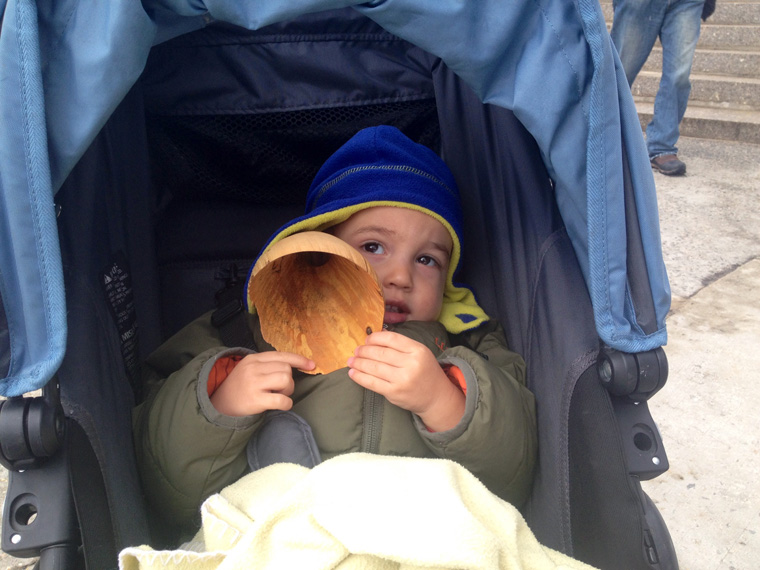Sound and Sight Walk in the North Woods of Central Park
March 8, 2015, facilitated by the Walk Exchange/NY
Participants responses:
“Your walk that day was magical. I never would have imagined being able to hear spring crackling through all that snow, but there it was, thanks to your beautifully crafted ear trumpets. It gave me such a feeling of hope and wonder. Thank you for that.
Not long after the walk Maureen called me and so yesterday we got together for lunch to discuss our experience--that's how much of an impression you made on us! We shared what had been most meaningful, and speculated on why the experience had moved us so deeply. We decided it had to do with how it was both a unique individual and collective experience, and one that spanned from minutia to something quite monumental. I think we both appreciated how beautifully you crafted not only those burls but also the route you took us along, which introduced me to part of the park I don't remember ever visiting. I also love that you were able to attract a group of strangers who left feeling like they wanted to know one another more.”
Lydia Matthews, Writer, curator, professor/Visual Culture and Director/Curatorial Design Research Lab at Parsons/The New School for Design
“I have been thinking about our Burl Sight & Sound Walk. Wandering and wondering, the movement that lets our imagination fly. How exquisite to pair this with your ear burls. How much I felt like a walking tree. The burl not so much amplifying sound as enhancing the quality of our presence in the landscape. Richness through a particular timbre. Each wood, each instrument's shape a tesseract opening.” Maureen Koelsch, Dancer, Imaginarian
“I really enjoyed being able to touch the unique ear trumpets and take a few moments to concentrate on hearing (and so did Peregrin). It was interesting because for me, it took a few moments to key into the sounds that were funneled... they felt on the "treble-y" side, and the details were amazing. It was like putting on a pair of glasses.” Dillon De Give, Artist, dad, teacher and Walk Exchange Co-Founder
The Sound and Sight Walks are based on contemplation of place, with emphasis on its sound as the focusing element. The walk in Central Park provided a variety of soundscapes from hardscape and traffic to birdsong and rushing waters. We focused on discrete sounds by using hand-carved wooden listening trumpets (Beethoven had several, for example). The devices used on the walk were carved from burls of trees common on the east coast, Maple, Oak, Box Elder and Elm. A burl is a tree growth in which the wood grain has grown in an abnormal manner due to an injury, either physical or microscopic. With trumpets in hand, participants listened to the urban streetscape of 5th Avenue the Conservatory Gardens and into the rustic woodlands. Our listening walk took us into The Ravine, the Huddlestone Arch, down the Loch Walking Path, by the Pool and into the North Woods, Central Park's largest woodland area, built to offer a retreat. The trumpets allowed us to hear in subtly different ways by placing an ear to the small end. Participants heard amplified sounds of water flowing, dry eaves rustling and birds calls as intermixed, or separated from, human-made sounds. During the walk, participants focused on differentiating sounds as we moved from the street to the woods. Periodically, we stopped and listened together, discussed what we were hearing, and exchanged listening trumpets, as each has unique acoustic qualities.
I hope that the use of the special instruments will deepen our listening experience and that we will hear more and more the longer we listen. The trumpets may also be used to isolate visual phenomena such as the play of light and shadow on particular surfaces or a beautiful patch of moss or lichen. Increased sensory perception is encouraged through concentrated listening and seeing, focused attention, and the isolation of particular sounds and sights.
Designing an experience, sculpting or composing it, in such a way that viewers must walk to discover it is, in itself, an act overlaid with many intentions. Walking with a focus on listening invites a slower pace and increases sensory perception. The fact that the piece is a walk, and therefore dispersed in time and space, calls upon the viewer to remember all the parts in order to experience the whole. In experiencing sound as geographical, the process is one of assembling sound into an aural picture of the landscape. The ear acts as the conduit between the outer world and the inner realm of each individual. Concentration on small visual fragments of great beauty in the environment can alter our perception of place and filter into our daily lives. The sights and sounds we are interested in on the Sound and Sight Walks are often so woven into the fabric of the everyday as to be scarcely noticed. Of central concern in this work is recognition of the importance of perceptual possibilities, of simple awareness. A cultivation of these facilities allows frequent conscious retreats from the usual patterns of our fast-paced lives, and nurture the human need to break from the mechanical rhythm of contemporary life. The sight and sound trumpets provide a way of cupping our ears and eyes to the earth.
The Central Park walk was 2 1/2 hours long. Participants were asked to dress appropriately for the weather conditions that day and to wear sturdy walking shoes







